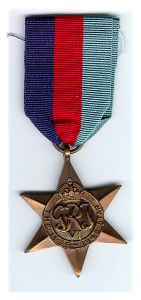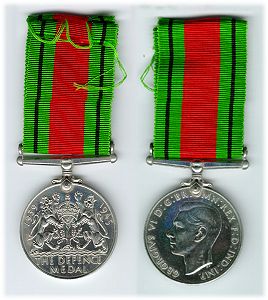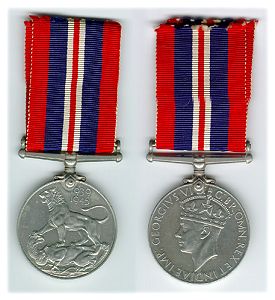1939-45 STAR
The first in a series of eight bronze stars issued for service in the Second World War, it was awarded to personnel who had completed six months’ service in specified operational commands overseas, between 3rd September 1939 and 2nd September1945, though in certain cases the minimum period was shortened. Any service curtailed by death, injury or capture also qualified, as did the award of a decoration or a mention in despatches. The clasp awarded to RAF aircrew for action during the Battle of Britain was denoted by a gilt rosette when the ribbon was worn alone.
Awarded for entry into an operational area in North Africa between 10th June 1940 (The date of Italy’s declaration of war} and 12th May 1943 {the end of operations in North Africa), but service in Abyssinia (Ethiopia), Somaliland, Eritrea and Malta also qualified for the award. A silver numeral 1 or 8 worn on the ribbon denoted service with the First or Eighth Army between 23rd October 1942 and 23rd May 1943.
North
Africa 1942-43 Bar
Awarded for service with the 18th Army Group Headquarters who did not qualify for either of the numerals between 15 February and 12 February 1943, or navy and merchant navy in shore service, OR Royal Air Force service who served under the command of the A.O.C. Western Desert, A.C.N.W. African Forces, A.O.C. Malta, or any others who operated against the Germans or Italians from 23 October 1942 to 12 May 1943. In undress, a rosette on the ribbon denotes this bar. The Merchant Navy for service on the North African coast between 23rd October, 1942, and 12th May, 1943, and participation in the landings on the Moroccan Coast between 8th November, 1942 and 12th May, 1943.
DEFENCE MEDAL
Awarded to service personnel for three years service in a non-operational area (e.g. India) or six months service overseas in territories subjected to air attack or otherwise closely threatened. Personnel of Anti-Aircraft Command, RAF ground crews, Dominion forces stationed in the U.K., the Home Guard, Civil Defence, National Fire service and many other civilian units qualified for the medal. The medal was generally issued unnamed in cupronickel, but the Canadian version was struck in silver. back to topWAR MEDAL
All fulltime personnel of the armed forces wherever they were serving, so long as they had served for at least 28 days between 3rd September 1939 and 2nd September 1945 were eligible for this medal. It was granted in addition to the campaign stars and the Defence Medal. E few categories of civilians, such as war correspondents and ferry pilots who had flown in operational theatres, also qualified. No clasps were issued with this medal but a bronze oak leaf denoted a mention in despatches. The medal was struck in cupronickel and issued unnamed, but those issued to Australian and South African personnel were officially named. The Canadian version of this medal was struck in silver.
|
|||||||||||||||||||||||||||||||||||||||||||||||||||||||||||||||||||||



